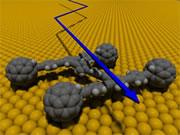 Vroom: this nanocar is made from a single molecule.© Y. Shira/Rice University
Vroom: this nanocar is made from a single molecule.© Y. Shira/Rice UniversityThe world's smallest toy cars have been set rolling.
They measure just 3 by 4 nanometres: a million of them parked bumper to tail would cover the length of a flea. And they are stripped down to the absolute basics: just a chassis and two axles with wheels at either end.
But they move. Using a powerful microscope, James Tour and his coworkers at Rice University in Houston, Texas, have watched their 'nanocars' trundle over a layer of gold1.
The axles and chassis are made primarily of carbon atoms linked into rigid rods that form an H shape. At each axle tip, the researchers attached a ball-like wheel made from the football-shaped carbon molecule C60.
The key question was whether these diminutive vehicles truly roll over a surface, or just skitter about because of their thermal energy, as many molecules do.
Wheel spin
Tour and his colleagues claim that the wheels must indeed be turning. When they used the fine tip of a scanning tunnelling microscope, a device normally used for imaging at the atomic scale, to attract the nanocars and pull them along, the cars moved forward but not sideways. That's just what you would expect to happen if the C60 molecules were rotating on an axis. Occasionally the cars pivoted and took off in a new direction, making zigzag paths.
Three-wheeled nanocars with tripod axles could only turn in circles, again as would be expected if the wheels were revolving.
"This is really exciting", says materials scientist Henry Hess of the University of Florida in Gainesville, who has used biological molecular motors to drive nanoscale objects over surfaces.
ADVERTISEMENT
Hess believes that it may become possible to use synthetic molecular motors, which other researchers are developing2 3, to power nanovehicles like this. "If you put these things together, you can see how they might be actively driven," he says.
If he's right, Tour's idea of using 'nanotrucks' and 'nanotrains' to transport materials for nanotechnological construction may one day get on the road.
University of Florida, Gainesville.
